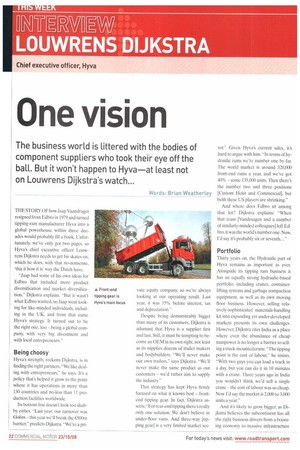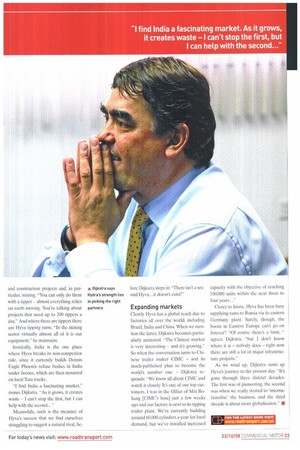One vision
Page 22

Page 23

If you've noticed an error in this article please click here to report it so we can fix it.
The business world is Uttered with the bodies of component suppliers who took their eye off the ball. But it won't happen to Hyva—at least not on Louwrens Dijkstra's watch...
Words: Brian Weatherley THE STORY OF how Jaap Vaandrager resigned from Edbro in 1979 and turned tipping-ram manufacturer Hyva into a global powerhouse within three decades would probably fill a book. Unfortunately, we've only got two pages, so Hyva's chief executive officer Louwrens Dijkstra needs to get his skates on, which he does, with that no-nonsense, 'this it how it is' way the Dutch have.
"Jaap had some of his own ideas for Edbro that included more product diversification and market diversification," Dijkstra explains. "But it wasn't what Edbro wanted, so Jaap went looking for like-minded individuals, including in the UK, and from that came Hyva's strategy. It turned out to be the right one, too being a global company, with very big divestment and with local entrepreneurs."
Being choosy
Hyva's strength, reckons Dijkstra, is in finding the right partners. "We like dealing with entrepreneurs," he says. It's a policy that's helped it grow to the point where it has operations in more than 130 countries and no-less than 11 production facilities worldwide.
Its bottom line doesn't look too shabby either. "Last year, our turnover was €446m this year we'll break the €500m barrier," predicts Dijkstra. "We're a pri vate equity company, so we're always looking at our operating result. Last year, it was 15% before interest, tax and depreciation."
Despite being demonstrably bigger than many of its customers, Dijkstra is adamant that Hyva is a supplier first and last. Still, it must be tempting to become an OEM in its own right, not least as its supplies dozens of trailer makers and bodybuilders. "We'll never make our own trailers," says Dijkstra.
never make the same product as our customers we'd rather aim to supply the industry."
That strategy has kept Hyva firmly focused on what it knows best frontend tipping gear. In fact, Dijkstra asserts: -For rear-end tipping there's really only one solution. We don't believe in under-floor rams. And three-way [tipping gear] is a very limited market sec tor." Given Hyva's current sales, it's hard to argue with him. "In terms of hydraulic rams we're number one by far. The world market is around 320,000 front-end rams a year, and we've got 40% some 135,000 units. Then there's the number two and three positions [Custom Hoist and Commercial], but both these US players are shrinking."
And where does Edbro sit among that lot? Dijkstra explains: "When that team [Vandraagen and a number of similarly-minded colleagues] left Edbro, it was the world's number one. Now, I'd say it's probably six or seventh..."
Portfolio
Thirty years on. the Hydraulic part of Hyva remains as important as ever. Alongside its tipping ram business it has an equally strong hydraulic-based portfolio, including cranes, containerlifting systems and garbage compaction equipment, as well as its own moving floor business. However, selling relatively-sophisticated materials-handling kit into expanding yet under-developed markets presents its own challenges. However, Dijkstra cites India as a place where even the abundance of cheap manpower is no longer a harrier to selling a truck-mounted crane. -The tipping point is the cost of labour," he insists. "With two guys you can load a truck in a day, but you can do it in 10 minutes with a crane. Three years ago in India you wouldn't think we'd sell a single crane the cost of labour was so cheap. Now I'd say the market is 2,000 to 3,000 units a year."
And it's likely to grow bigger, as Dijkstra believes the subcontinent has all the right business drivers from a booming economy to massive infrastructure and construction projects and, in particular, mining. "You can only do them with a tipper — almost everything relies on earth moving. You're talking about projects that need up to 200 tippers a day." And where there are tippers there are Hyva tipping rams. "In the mining sector virtually almost all of it is our equipment," he maintains.
Ironically, India is the one place where Hvva breaks its non-competitor rule, since it currently builds Dennis Eagle Phoenix refuse bodies in India under licence, which are then mounted on local Tata trucks.
"I find India a fascinating market," muses Dijkstra. -As it grows, it creates waste —I can't stop the first, but I can help with the second..."
Meanwhile, such is the measure of Hyva's success that we find ourselves struggling to suggest a natural rival, be fore Dijkstra steps in: "There isn't a second Hyva...it doesn't exist!"
Expanding markets Clearly Hvva has a global reach due to factories all over the world. including Brazil, India and China. When we mention the latter. Dijkstra becomes particularly animated. "The Chinese market is very interesting — and it's growing." So when the conversation turns to Chinese trailer maker CIMC — and its much-publicised plan to become the world's number one — Dijkstra responds: "We know all about CIMC and watch it closely. It's one of our top customers. I was in the Office of Mai Bohang [CIMC's boss] just a few weeks ago and our factory is next to its tipping trailer plant. We're currently building around 60,000 cylinders a year for local demand, but we've installed increased capacity with the objective of reaching 100,000 units within the next three to four years..."
Closer to home. Hyva has been busy supplying rams to Russia via its eastern Germany plant. Surely, though, the boom in Eastern Europe can't go on forever? "Of course there's a limit, " agrees Dijkstra, "but I don't know where it is — nobody does — right now there are still a lot of major infrastructure projects."
As we wind up. Dijkstra sums up Hyva's journey to the present day: "It's gone through three distinct decades. The first was of pioneering, the second was when we really started to 'intemationalise' the business, and the third decade is about more globalisation." •








































































































































































